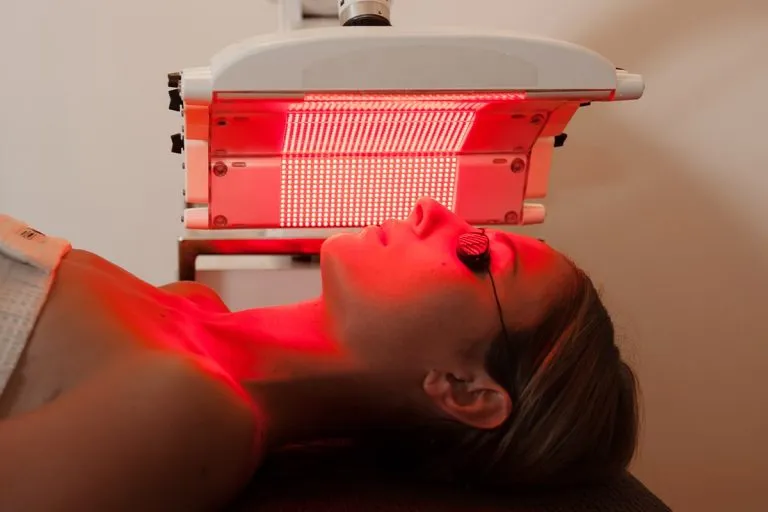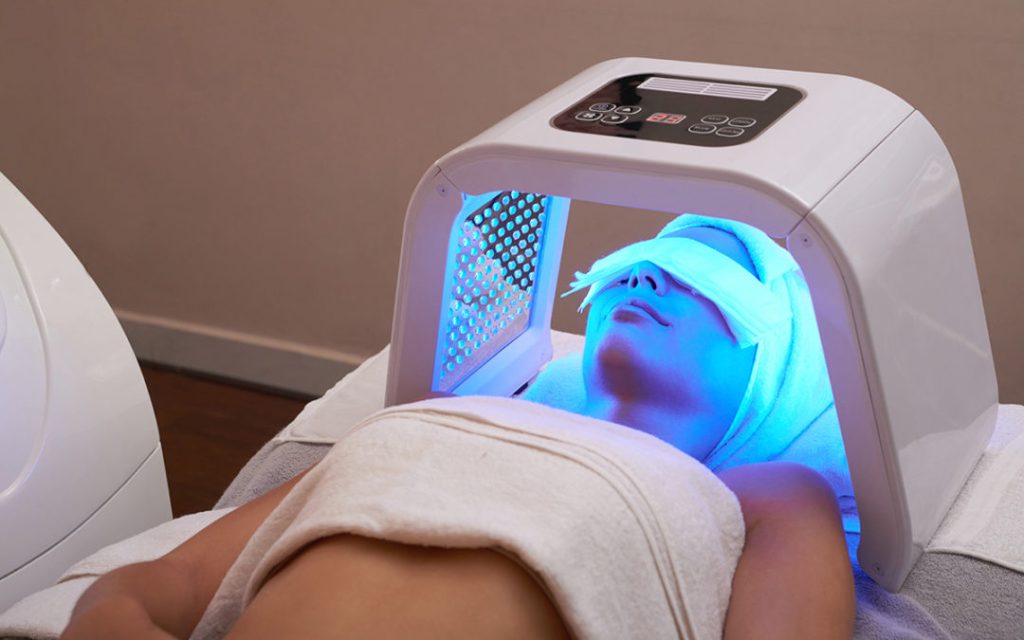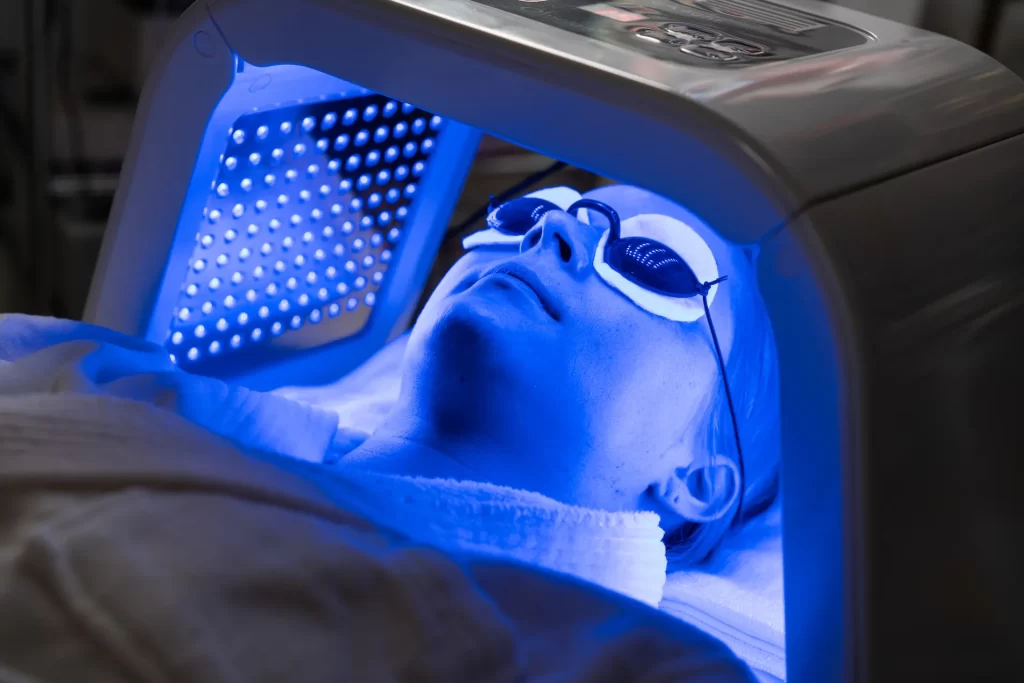In the quest for optimal skin and health, red light therapy vs blue light therapy present unique advantages. Red light-emitting diodes are highly effective at reducing inflammation and increasing circulation, which can penetrate deeper into the human body to assist in wound treatment, pain management, and even to treat other medical conditions. Conversely, blue light targets the skin’s surface, using specific wavelengths of light to combat acne-causing bacteria, offering a promising skincare treatment for those battling mild to moderate acne.
While red light reduces signs of aging by reducing wrinkles and sun damage, blue light therapy is adept at addressing issues like sun spots and other blemishes present in sunlight but without exposing the skin to harmful UV rays. Both therapies leverage the numerous benefits of light treatments within the visible light spectrum, but it’s the therapeutic benefits of their distinct wavelengths that make the choice between blue and red light therapy a pivotal one for your health and skincare needs.
Understanding LED Light Therapy
LED light therapy harnesses light energy to trigger natural healing processes in the body. This low-level light therapy, which operates across a spectrum of redness and inflammation reducing wavelengths, offers a non-invasive method to improve skin health and more. Whether used solo or in a combination of red and blue light, LED therapy is a versatile approach to treating a variety of skin conditions and promoting overall well-being.
The technology behind LED light therapy is grounded in the principles that have been used for plant growth experiments and photodynamic therapy. The light energy emitted by LED lights is absorbed by the skin and used to stimulate cellular repair and rejuvenation, helping to alleviate a wide range of skin-related issues with minimal risk.
The Science Behind LED Light Therapy
At the core of LED light therapy is the principle that light energy is converted into cellular energy. Red LED light therapy, for instance, activates chromophores in the skin similar to how sunlight triggers photosynthesis in plants, albeit without the damaging effects of UV rays. This activation spurs a cascade of metabolic events, resulting in increased collagen production and tissue repair.
On the other hand, blue light therapy and blue light specifically targets the bacteria that cause acne, producing oxygen radicals that eradicate these harmful microorganisms without harming the surrounding tissue. The combination of red and blue light can hence offer a comprehensive treatment, addressing both the underlying bacteria and the inflammation associated with acne.
Red Light Therapy Explained
Red light therapy operates on the premise that certain wavelengths of light can stimulate the body’s natural healing mechanisms. By delivering a precise wavelength that penetrates the skin, red light therapy reduces inflammation and increases circulation, which in turn supports healthier skin and tissue repair. Unlike UV rays present in sunlight, the light from red light therapy devices does not cause damage to the skin or underlying tissues.
Boosting Cellular Energy With Red Light Therapy
Red light therapy harnesses specific wavelengths of light to stimulate the mitochondria within cells, enhancing their ability to produce energy. This boost in cellular energy can have far-reaching effects, from improving skin health to enhancing muscle recovery. With red light therapy vs other treatments, users often report significant improvements in both appearance and function, attributable to this increase in energy production at a cellular level.

Blue Light Therapy: An Overview
Blue light therapy utilizes the wavelengths of light that are known to have antibacterial properties, particularly against acne-causing bacteria. As a part of a comprehensive skin treatment plan, blue light therapy can be particularly beneficial for those struggling with persistent acne.
The specific wavelengths employed by blue light can disrupt the life cycle of acne-causing bacteria, leading to an improvement in the skin’s appearance without the use of harsh chemicals or medications.
Blue Light’s Role in Treating Acne and Surface Skin Issues
Blue light therapy stands out in its ability to address acne and other surface skin issues. Its particular wavelength targets and neutralizes acne-causing bacteria that reside on the skin’s surface, making it an effective treatment for those looking to reduce the presence of acne. When used consistently, blue light therapy can help maintain clear skin and prevent future breakouts.
Red or Blue Light Therapy: Core Differences
When comparing red and blue light therapies, the core differences lie in their respective wavelengths and therefore their applications. Red light is better suited for treating deeper skin layers and addressing issues like inflammation and pain, while blue light is more effective for surface-level skin concerns, such as acne. Each therapy provides safe and effective treatment options tailored to specific needs.
Distinct Wavelengths, Diverse Effects
Red and blue light therapies utilize distinct wavelengths within the electromagnetic spectrum to achieve diverse therapeutic benefits. Red light is known for its ability to penetrate deeper into the skin, reaching muscle tissue and even bone, while blue light primarily affects the outermost layer of the skin. This difference in penetration depth allows each type of therapy to be specialized for different health and skincare goals.
Understanding the unique properties of these light wavelengths is crucial in determining the appropriate therapy for individual conditions. While red light may be better suited for conditions requiring deep tissue treatment, blue light’s precision makes it ideal for targeting specific surface skin issues.
Targeted Treatments: Red Light for Deep Tissue vs Blue Light for Surface Skin
Red light therapy, with wavelengths that can reach up to 630 nm, is engineered to relieve pain and promote healing in deeper body tissues, including muscle pain and discomfort. Its ability to penetrate beyond the topmost layer of the skin allows it to be a safe and effective treatment for a range of deeper-seated issues. Blue light’s shorter wavelengths, however, are adept at treating conditions that affect the skin’s surface, making it a go-to option for acne management and other epidermal concerns.
The choice between red and blue light therapy often comes down to the specific condition being treated. While red light can effectively reach and rejuvenate muscle tissue, blue light is excellent for combatting bacteria and conditions that manifest on the skin’s surface.
The Specific Benefits of Red Light Therapy
Red light therapy offers a multitude of specific benefits, from enhancing skin health to providing pain relief for various body aches and conditions.
Red Light Therapy for Pain Relief and Skin Rejuvenation
Near-infrared light, a component of red light therapy, can deeply penetrate the skin, improving blood circulation and promoting skin rejuvenation. This makes it an effective addition to your skincare routine, helping to reduce acne and stimulate collagen stimulation. The benefits of red light therapy extend to pain relief, where its anti-inflammatory effects can be particularly soothing. Additionally, its influence on sleep patterns and circadian rhythm can be leveraged to improve overall wellness.
Harnessing the Benefits of Red Light Therapy
Red light therapy is not only beneficial for skin rejuvenation and reducing acne but also plays a role in enhancing your overall health. By incorporating near-infrared light into your skincare routine, you can stimulate collagen production, boost blood circulation, and even potentially regulate sleep patterns. The benefits of red light therapy are wide-ranging, offering an effective, non-invasive option for maintaining both skin health and general well-being.
Anti-Aging Effects: How Red Light Can Reduce Wrinkles
The anti-aging effects of red light therapy are significant, particularly in its ability to reduce the appearance of wrinkles. Near-infrared light helps to promote blood circulation and skin rejuvenation, which in turn stimulates collagen production. This not only improves the skin’s elasticity but also diminishes fine lines and wrinkles, making red light therapy a valuable component of any skincare routine aimed at reducing signs of aging.
Pain Management: Alleviating Discomfort with Red Light
Red light therapy has been shown to be an effective modality for pain management, reducing discomfort in various body parts. Its ability to enhance blood flow and reduce inflammation helps to alleviate pain, making it a beneficial treatment for chronic conditions as well as acute injuries. The therapeutic light can treat deep-seated pain by reaching the affected muscle tissue and initiating the body’s natural healing processes.
Therapeutic Outcomes of Consistent Red Light Therapy Use
When you stick with red light therapy, you might notice a transformation in your well-being. This form of treatment is renowned for its ability to rejuvenate skin and enhance muscle recovery, making it a favorite among athletes and those with active lifestyles. Over time, consistent use can lead to noticeable improvements in skin appearance and a reduction in muscle fatigue.
Accelerated Healing and Reduced Inflammation
Red light therapy goes beyond skin deep, promoting healing within your body. It’s known to reduce inflammation, which can be a game-changer if you’re dealing with chronic pain or sports injuries. The light penetrates your tissues, accelerating the healing process and providing relief that feels like a weight has been lifted off your shoulders.

The Role of Blue Light in Skin Therapy
Blue light therapy stands out in the realm of skincare, especially for its targeted action against stubborn acne. By zeroing in on the bacteria that cause breakouts, this therapy offers a beacon of hope for those fighting the ongoing battle for clear skin.
Bacterial Inhibition and Acne Management
When it comes to acne treatment, blue light therapy shines by targeting and inhibiting the bacteria responsible for acne. It’s a game-changer for managing oil production and preventing future breakouts. LED light therapy devices make this technology accessible, empowering you to take control of your skin health from the comfort of your home.
Blue Light as a Skincare Ally
Blue light therapy isn’t just for acne; it’s a skincare ally that tackles a range of issues. By calming inflammation and reducing redness, it enhances your skin’s overall appearance. Regular sessions can lead to a noticeable improvement, making your skin look and feel healthier and more vibrant.
From Mild to Moderate Acne: Blue Light’s Efficacy
A study showed that blue light therapy is effective for not only mild but also moderate acne. This non-invasive treatment option can reduce the severity of breakouts and, over time, can lead to clearer, more balanced skin. It’s a promising solution for those who haven’t found success with traditional acne treatments.
Combining Red and Blue Light Therapy for Enhanced Results
For those looking to amplify their light therapy results, combining red and blue light can be a powerful strategy. This dual approach can tackle a wide spectrum of skin concerns, from acne to aging. The red light works to rejuvenate deeper tissues, while blue light focuses on surface-level skin issues.
The synergistic effects of these therapies can lead to improved skin texture, tone, and overall health. By addressing various layers of the skin, the combined treatment can offer a more comprehensive solution for your skincare needs.
Synergistic Approach to Light Therapy
The combination of red and blue light therapy creates a synergistic effect that maximizes the benefits of each. This approach can lead to a more holistic improvement in skin health, tackling issues from the surface to deeper layers. It’s like having a one-two punch in your skincare arsenal, offering enhanced results that are greater than the sum of their parts.
Increased Collagen Production
One of the most sought-after effects of red light therapy is its ability to stimulate collagen production. This protein is crucial for maintaining the strength and elasticity of your skin and connective tissue. It also plays a role in the healing process, helping to minimize the appearance of acne scars and promote smoother, more youthful skin.
Improved Skin Texture and Tone
At-home devices have made it easier than ever to improve your skin texture and tone. By harnessing the power of red light and blue light, you can target signs of aging and manage oil production more effectively. These devices can also help address a variety of skin concerns, providing a range of treatment options to suit your individual needs.
Practical Aspects of Light Therapy at Home
Bringing light therapy into your home can revolutionize your skincare routine. It’s a convenient way to get professional-level results without the need to visit a clinic.
Frequency and Duration: How Often to Use Light Therapy Devices
To reap the benefits of light therapy devices, consistency is key. Most manufacturers recommend daily or multiple weekly sessions, ranging from a few minutes to longer durations, depending on the specific condition being treated and the device’s instructions.
Selecting the Right Light Therapy Device for Home Use
Choosing the right light therapy device means considering your specific skin needs and lifestyle. Look for devices with proven efficacy, positive user reviews, and the necessary safety certifications to ensure you’re making a wise investment in your skin health.
Features to Consider in At-Home Light Therapy Devices
When selecting at-home light therapy devices, consider features such as wavelength range, treatment size, and ease of use. Devices that complement your body’s natural healing processes and fit seamlessly into your daily routine can enhance your experience and the effectiveness of the treatment.
Precautions and Considerations
While exploring the potential of light therapy, it’s crucial to proceed with caution. Understanding the risks and ensuring proper usage are key steps in preventing unwanted side effects. Always consider your skin’s sensitivity and consult with a healthcare provider to tailor a safe regimen for your unique needs.
Understanding the Safety Profile of Red and Blue Light Therapy
Both red and blue light therapies are generally considered safe, with minimal side effects. Red light therapy is known for its gentle biological effects, while blue LED light therapy typically does not cause harm to the skin. However, it’s important to use these treatments as directed to avoid potential eye strain or skin irritation.
Potential Risks Associated With Red and Blue Light Therapy
Though risks are low, they do exist. Prolonged exposure to light therapy without eye protection can lead to eye strain or damage. Overuse may also cause skin redness or inflammation. It’s essential to follow manufacturer guidelines and use protective gear as recommended to mitigate these risks.

Supporting Your Body’s Defense System When Making the Right Choice
Choosing between red and blue light therapy depends on your personal health objectives and skin concerns. Evaluate the benefits and potential risks to make an informed decision that aligns with your wellness goals.
Which Light Therapy Is Best Suited for You?
Consider red light therapy if you’re seeking pain relief or skin rejuvenation, and blue light therapy for acne management and bacterial inhibition. Your choice should reflect your specific health needs and the outcomes you desire from the therapy.
- Evaluating Your Skin Concerns and Health Objectives
Analyze your skin’s condition and your health goals before deciding on a therapy. Red light may be your ally in combating wrinkles and promoting healing, while blue light could be the answer to persistent acne. Reflect on what you hope to achieve to guide your choice.
- Guidance on Selecting Between Red and Blue Light Therapy
When selecting a therapy, consider the depth of skin issues you’re addressing. Red light excels in deep tissue repair and anti-aging, whereas blue light targets surface-level skin problems like acne. Your specific concerns should steer your decision towards the appropriate light therapy.
Concluding Thoughts on Light Therapy Choices
As you consider integrating light therapy into your wellness routine, weigh the distinct advantages and applications of red versus blue light. Red light therapy aids in deep tissue repair and anti-aging, while blue light therapy is a powerful combatant against surface-level skin issues like acne. Both therapies have a place in skincare and health maintenance, depending on your individual needs.
Ultimately, your decision should be informed by the specific conditions you wish to treat and the outcomes you aim for. Always observe safety precautions, such as using eye protection and adhering to recommended exposure times. With the right approach, light therapy can be a safe and effective component of your health regimen. Remember to consult with a healthcare provider to ensure the chosen therapy aligns with your unique skin and health profile.
